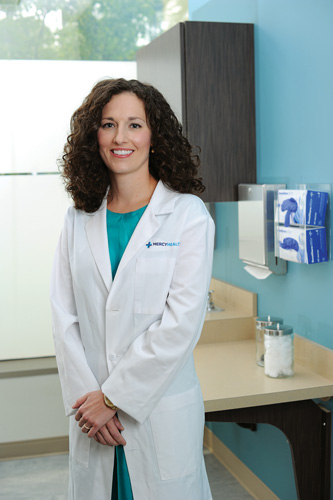A look at medical and wellness issues that affect the daily lives of business executives
by Lynne Thompson
“Liberally apply a full-spectrum sunscreen with a sun protection factor (SPF) of at least 30 to all areas of exposed skin. Reapply every 90 minutes to two hours, every hour when swimming.”
Skin-cancer-wary dermatologists recite the mantra over and over again as temperatures rise and their patients begin heading outside again. So happy to feel the sun’s warmth after a long, cold winter, many people forget the dangers of unprotected exposure to its rays. Dr. Emily Moosbrugger, a dermatologist at Mercy Health – Kenwood Dermatology in Cincinnati, cites an American Academy of Dermatology statistic that serves as a reminder.

“About one in five Americans will be diagnosed with skin cancer at some point in his or her lifetime—and the incidence is increasing,” she says.
Fortunately, even the most serious of these abnormal growths can be treated successfully if they are caught early enough. Moosbrugger and Dr. Joshua Arbesman, an associate staff dermatologist in the Cleveland Clinic Dermatology & Plastic Surgery Institute, describe the three types of skin cancer:
Basal cell carcinoma. The most common skin cancer is typically a slow-grower, presenting itself in forms ranging from a flat pink or red spot to a pink, red or white bump, perhaps pearly in appearance. Moosbrugger observes that, depending on the appearance, patients can mistake it for a pimple or scar. Occasionally, it can scab or develop into an open sore.
“The duration of it is a clue,” she says. “If you have an acne bump that comes up, and it’s still there four weeks later but going away, that’s still probably an acne bump. If you have a spot that comes up, and two or three months have gone by and it hasn’t budged, that’s more concerning.”

Squamous cell carcinoma. This cancer often distinguishes itself with a rough scale or crust on a pink or red patch, one that Arbesman says can be painful or bleeding. He notes that it can develop from an actinic keratosis, a precancerous lesion he describes as “a red, scaly spot on long-term sun-exposed areas such as the face, back of hands, back of arms.”
Although squamous cell carcinomas are generally slow-growing, Moosbrugger says there is a subset that can grow very quickly.
“I’ve had patients that showed up with something that popped up within a matter of three, four weeks and [was] the size of a marble that grew very quickly over that period of time,” she says. “That can be a good clue, sometimes, that it’s a squamous cell.”
ABCDEs of melanoma
The most serious form of skin cancer appears as a mole or freckle that exhibits one or more of the characteristics Arbesman and Moosbrugger call “the ABCDEs of melanoma”:
Asymmetrical. “One half of the lesion [does] not [match] the other,” Arbesman says.
Border irregularity. “Instead of a nice, round mole, it’s more jagged or not uniform,” he says.
Color variability. “If it is blue, brown, black in some areas, pink in other areas, that is a red flag,” Moosbrugger cautions.
Diameter. Anything bigger than a pencil eraser needs to be checked. “Some melanomas, obviously, are going to start out smaller than that,” Arbesman qualifies. “And some benign lesions will be larger.”
Evolving. A mole that changes in appearance over time, Arbesman notes, or looks different than the rest of the moles on the body “is clinically called the ugly duckling,” and “not a good thing.” However, only 20 to 30 percent of melanomas develop from an existing growth, according to Moosbrugger.
“Most of the time, they are a new spot that comes up,” she says. “So particularly be on the lookout for something new and different that you didn’t have before.”
Arbesman recommends conducting regular skin examinations, or, better yet, scheduling an appointment with a dermatologist to do it. Melanomas, for example, can develop where the sun literally doesn’t shine. And the new-and-different component of “evolving” is also important in identifying basal and squamous cell carcinomas.
“You get a comfort level of what’s normal on your skin and what’s not,” he says of the result.
OUR EXPERTS
Dr. Emily Moosbrugger
dermatologist
Mercy Health – Kenwood Dermatology, Cincinnati
Dr. Joshua Arbesman
associate staff dermatologist
Cleveland Clinic Dermatology & Plastic Surgery Institute, Cleveland
